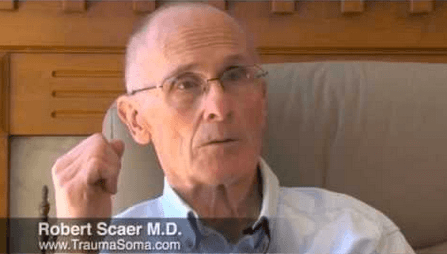
Author of “8 Keys to Brain-Body Balance” and
“The Trauma Spectrum”, Dr. Scaer is well-known among body-based practitioners.
He was recently interviewed by Dr. David Van Nuys aka “Dr. Dave” of ShrinkRapRadio on how trauma affects not only your sense of emotional well-being but your health as well – even if there are no physical injuries that show!
Dr. Dave of ShrinkRapRadio.com interviews leading authors, neuroscientists, neurologists, mind- body specialists. His site has been a valuable resource for therapists and soon-to-be therapists alike since 2005. (Also a great place to get CE credits if you’re a therapist 🙂
In this interview, Dr. Scaer relates how he came to study trauma, and what influenced his approach. He explains that trauma is stored as memory patterns in the brain. When a trauma pattern is allowed to complete itself, symptoms are reduced or extinguished entirely.
Click the link below to access the interview. It will open in a new window and you’ll be taken off site to “Dr. Dave’s” ShrinkRapRadio.

*Posted with permission from Dr. David van Nuys
[Keep this page open so you can reference the terms used in this podcast. Scroll down to find highlights you can use to follow along or jump to specific passages in the interview.]
@ 1:00 – introducing Dr. Scaer: background, research specialties, “Eight Keys to Restoring Brain-Body Balance”.
@ 5:21 – his work with Dr. Peter Levine; how thoughts about “conversion hysteria” were misinterpreted initially.
@ 10:45 – the nature of whiplash and its connection with the emotions.
@ 11:45 – PTSD is just the tip of the iceberg…only a tiny portion of the symptom complex.
@ 13:22 – in PTSD the traumatic events are held in procedural (ie unconscious) memory; they keep coming back when related cues appear in the environment. It’s classic fear conditioning.
@ 14:26 – conventional PTSD therapies tend to be inadequate because they don’t extinguish the body memories; they don’t incorporate the body sensations and unfulfilled movement patterns associated with the traumatic event.
@ what Dr. Scaer learned from a Brazilian Shamanic healing journey.
@ 23:00 – Chapter review of “Eight Keys to Restoring Brain-Body Balance”
Get it at Amazon: 8 Keys to Brain Body Balance
@ 25:00 – discussion of brain plasticity and its negative role in trauma.
@ 27:00 – and explanation of the dictum: “neurons that fire together, wire together”.
@ 28:50 – why dreams are critical to health and memory retention.(Very interesting!)
@ 31:18 – the importance of epigenetics and trauma – how genes are affected by environment.
@ 33:28 – poses the question whether autism is based on a gene disorder caused by negative childhood experiences.
@ 34:45 – discusses Alan Schore’s theory of mother-infant attunement and bonding, based on brain function and the orbito-frontal cortex (which controls and modulates emotions). Conclusion: lack of attunement results in a dysregulated autonomic nervous system and emotional brain.
@ 36:25 – speculates that a 40% C-section rate could explain why many mothers don’t bond with their infants. (That is, that the mother is suffering the painful effects of the surgery and is therefore ill-equipped to attune to their infants in the first few weeks since the birth of their baby.)
@ 37:20 – speculates that traumatic memories could be genetically inherited (e.g. Holocaust victims appear to pass on the trauma to their children).
@ 40:16 – stress vs. trauma; the effects of elevated cortisol levels on the hippocampus. [The hippocampus is where our “everyday” memories are stored.]
@ 42:30 – meditation, especially breath work, shuts down the part of the brain that causes chronic low level arousal, and thus modulates the stress response.
@ 45:19 – frames trauma as an unresolved, undischarged, incomplete freeze response.
@45:30 – recalls the National Geographic film where a tagged polar bear completes act of escape when coming out of sedation.
@ 47:30 – how a sustained, low grade freeze response underlies irritable bowel syndrome, ulcerative colitis, esophageal reflux disease, fibromyalgia, etc.
@ 49:40 – the amygdala (= the arousal center in the emotional brain) perpetuates trauma; we need to turn off the amygdala in order to extinguish the procedural memories associated with the trauma.